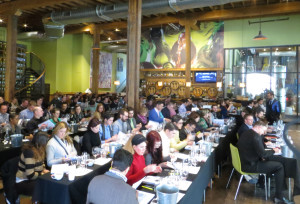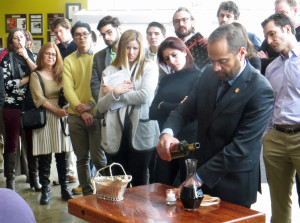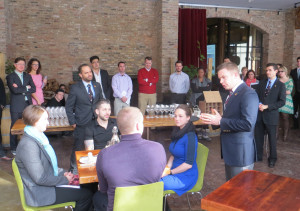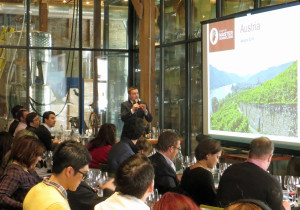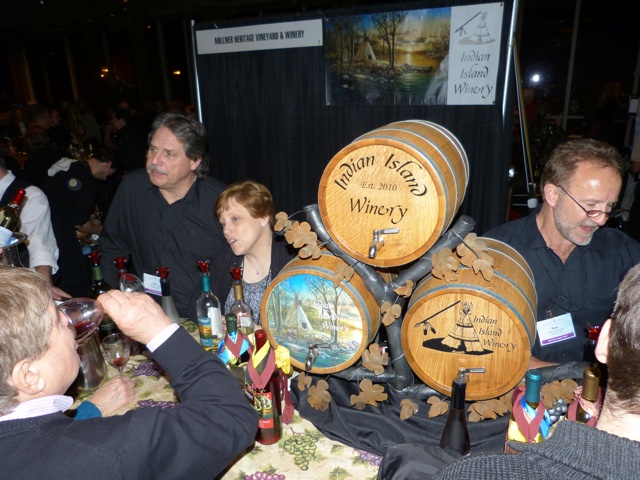Court of Master Somms Courts the Midwest
I have a confession to make. When I started Midwest Wine Press, I thought a modest amount of wine knowledge would be enough. After all, we’re mainly reporting wine news, not making it.
But I soon learned that if you’re in the wine business, people expect you to know everything about wine. So when the Court of Master Sommeliers contacted me about taking their Introductory Sommelier Course and examination, I knew it was time to get serious.
Professional designations are becoming more important in all lines of work. In my day job, I am a Certified Financial Planner. (This designation entails a ten-hour exam with a 50% pass rate.)
The CFP mark shows that I’m serious about my primary profession, and I think it’s important to earn a designation that shows people that I’m serious about wine.
Over the years, I have taken a number of wine classes, but most have been as much entertainment as education. Not so for the Court’s Introductory Somm Course and exam. Unless you know a lot about wine coming in, the 15 hour introductory class will not be enough. You’ll have to hit the books to pass the exam, as I did.
The Chicago class was taught by Master Sommeliers Serafin Alvarado, Jesse Becker, Fernando Beteta, and Joe Spellman. (Having four Master Somms as instructors is impressive, considering only 135 people hold the Master Sommelier designation in North America.)
All four Master Somms have traveled the world tasting wine. Their global perspective makes the class entertaining and rewarding. But the best part is the guided blind wine tastings.
Question: If you got a wine and had absolutely no idea what it was, how would you figure it out?
Using the Court’s deductive tasting method, of course. There’s not space here to describe the Court’s blind tasting process, but it begins with forming a list of wines that can used as benchmarks. The rest of the deductive method is part logic and part sensory analysis.
Keep in mind that The Court of Master Sommeliers is an organization that values tradition. The designation started in England in 1969 and still contains some remnants of training for English butlers.
While this old world sophistication gives the Court a certain elan, the message sometimes comes across as stodgy. For example, students are told that Napoleon’s 1855 Bordeaux classifications are ‘still a good guide to quality today.” (Perhaps that’s true if cost is no consideration.)
Despite the traditional roots of the Court , it’s possible to discern two emerging wine trends based on the 20 or so wines that were poured during the February class. First, there is a movement away from overly extracted, tannic wines. Also, based on the wines we tasted, acidity is now ‘in.” Both these trends bode well for Midwest wine.
That’s not to imply that the Midwest enters the Master Sommelier world much. In the Somm class workbook, we fall in the ‘other state” category; although one of instructors said, ‘Leelanau (MI) makes some great sparkling wines.” He went on to add, ‘It (sparkling wine) is a great way to manipulate substandard fruit.” (Ouch.)
Not much was said about hybrids either. The only comment about native wine grapes is that they ‘are not fun to drink.”
However, at least two of the Chicago Master Somms are interested in Midwest wine. Serafin Alvarado, who is also the director of wine education at Southern Wine and Spirits, will be touring Michigan wineries this spring in preparation for a Chicago wine event at City Winery that’s being organized by the Michigan Grape and Wine Industry Council.
Jesse Becker, a Master Somm from Nebraska, is also supportive of Midwest wine. He told Midwest Wine Press, ‘I am hugely optimistic and I think it’s clear from what I’ve been tasting that both the quality of the wines and the sophistication of the Midwest wine consumer are advancing quickly.”
Becker said a fellow Master Somm from Michigan, Ron Edwards of Charlevoix, recently shared a ‘stunning” bottle of sparkling wine from Michigan’s Leelanau Peninsula and a ‘top quality” Michigan Blaufränkisch. ‘Who knew?!” Becker said of the Michigan wines.
For people who make Midwest wine, the influence of the Court of Master Sommeliers is worth noting. The Chicago Introductory class had over 100 attendees, many coming from out-of-state. Attendees were mainly employees of Midwestern restaurants, hotels, retailers and distributors. The purpose of any certifying organization is to indoctrinate its students, and one’s preferences can’t help but be shaped by such an intense experience.
Perhaps because it’s face paced and intense, the Master Somm designation is becoming more sought after. Last year, 4,238 people attended the Introductory Somm class nationally, a 27% increase since 2011.
If one reason for Midwestern winemakers to get involved with The Court of Masters Sommeliers is to give the Midwest a greater voice in the wine industry, another is to gain more insight into their own wines.
‘All of us are guilty of ‘house palate,'” Becker said. ‘We hope students walk away with a new perspective and a broader view of the wine world. It’s for this reason, I believe Midwest winemakers might wish to pursue a course like ours.”
For more information, visit Court of Master Sommeliers America
[stextbox id=”alert” shadow=”true”]
Introductory Sommelier Course Classes in the Midwest for 2014
Sioux Falls- April 8,9
Kansas City- July 7,8
Omaha- August 25,26
Indianapolis- Sept. TBD
Traverse City- Oct. 6,7
[/stextbox]

